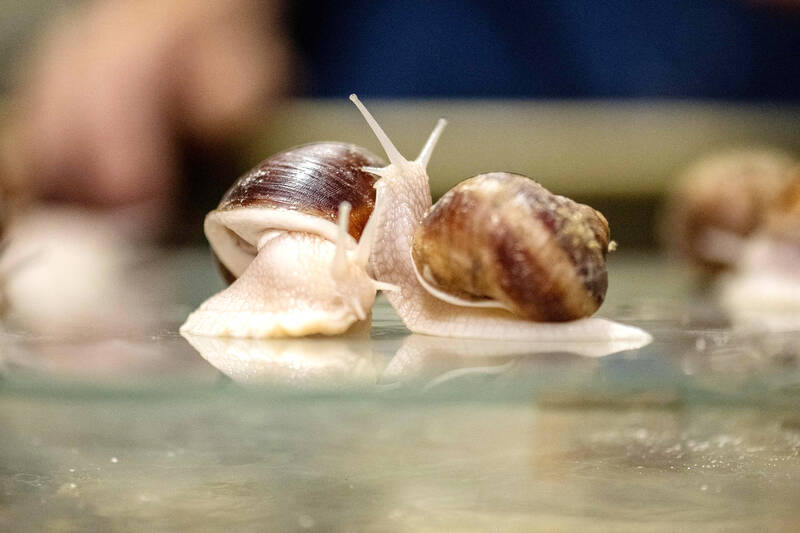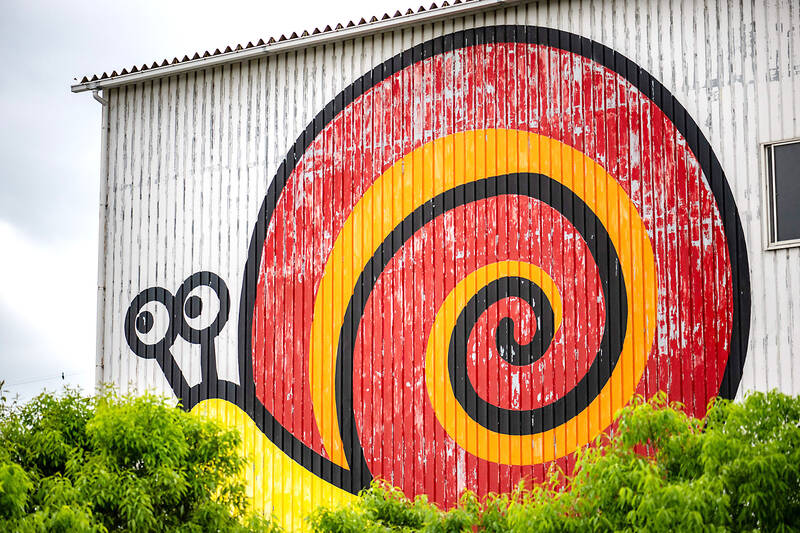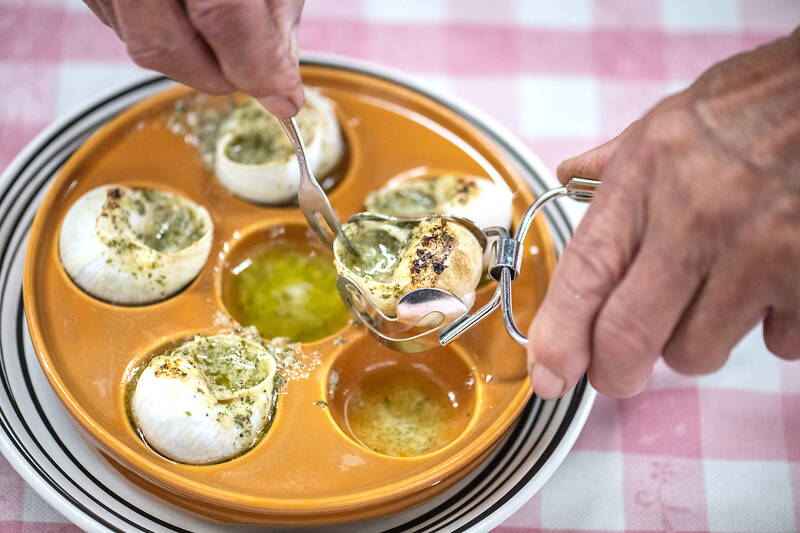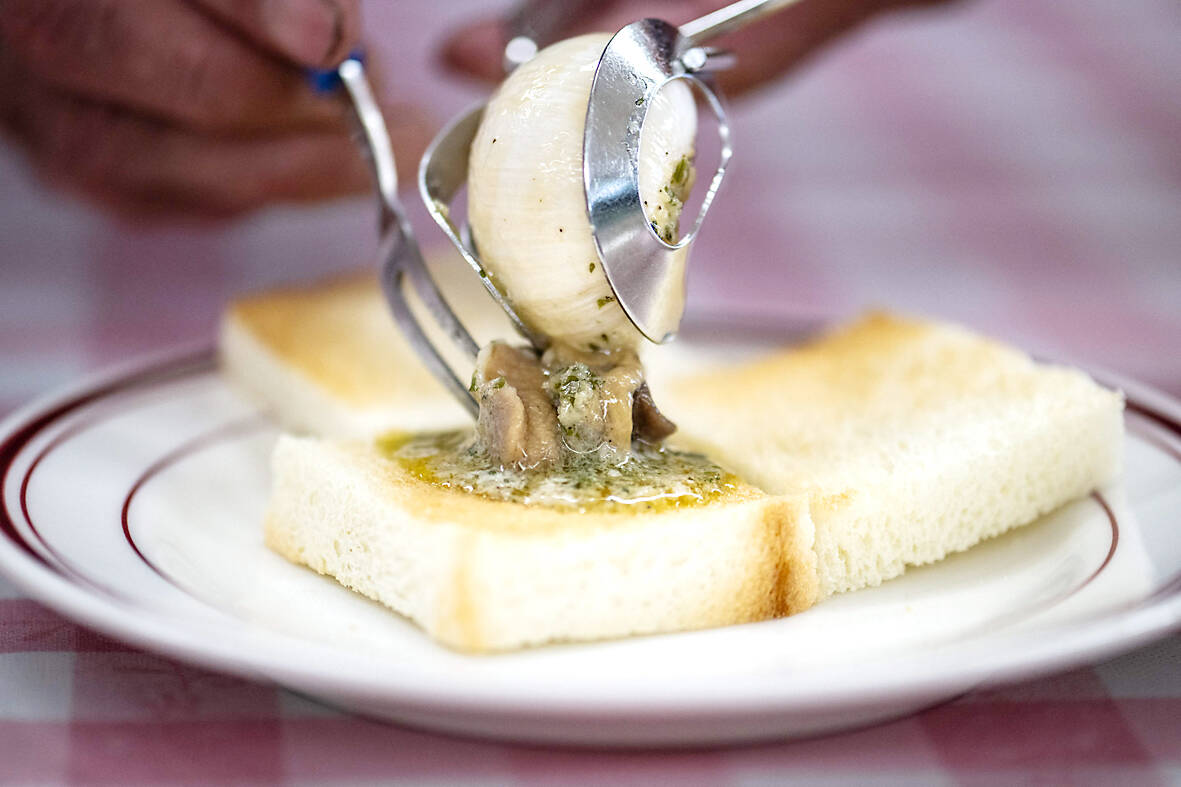Far from Parisian bistros serving up Burgundy snails, one Japanese man has figured out how to farm the slimy species — a feat that has long eluded the French.
Toshihide Takase, 76, says he is “the only person in the world” breeding this specific delicacy after four decades of trial and error to find the right conditions.
French embassy and industry insiders also believe that Takase, who has invested a small fortune and taught himself everything about the creature, is a unique case.

Photo: AFP
Stuffed with butter, garlic and parsley then baked, Burgundy snails — or escargots de Bourgogne — have been part of French gastronomy since the 19th century.
But they are notoriously difficult to farm because they don’t take well to crowded conditions and grow slowly, usually taking two or three years to reach adult size.
The mollusk, whose scientific name is helix pomatia, has been a protected species in France since 1979 to save it from extinction.

Photo: AFP
The vast majority of the several thousand tons of snails eaten by the nation each year are foraged from woodlands in central and eastern Europe.
Around five percent are homegrown in France, but these are a different species, helix aspersa, which are easier to farm and do not have the “Burgundy” name.
“My sister gave me tinned escargots as a present after a trip to France” 45 years ago, Takase said.

Photo: AFP
“But they didn’t taste good, and smelled bad,” said the retired entrepreneur.
Takase became obsessed with producing them himself, even though “at first, everybody acted like I was stupid.”
PERFECT CONDITIONS

Photo: AFP
He stubbornly devoured books on the subject and met French helix aspersa breeders to learn more.
It’s a niche interest anywhere, but highly unusual in Japan, where sea snails are part of the rich cuisine but land snails are seen as a pest that can harm crops.
After seven years of bureaucratic wrangling, Takase was granted a permit to rear helix pomatia and imported 100 specimens from France to start his farm.
The indoor facility in Matsusaka, a town between Osaka and Nagoya, is called the Mie Escargots Development Laboratory.
Crates of live Burgundy snails are stacked in three layers on custom-built metal racks, with humidity and temperature carefully controlled.
Next door is an active metalwork foundry — the first business set up by Takase, who used to manage several ventures.
He says the farm can produce up to 600,000 snails a year, with growth time reduced to just four months.
To achieve this, he adds a calcium-rich powder made from oyster shells to the humid soil, which helps the gastropods grow big and strong fast.
“They love it,” said Takase, who spent 20 years developing his own nutritious snail food from soybeans and corn.
Their feeding containers are washed by hand every three days, because “snails love cleanliness,” he added.
‘AT WHAT PRICE?’
Visitors to the “laboratory” get the chance to taste Takase’s snails, which cost 9,900 yen (US$60) for a pack of 30. There are different prices for restaurants or bulk sales.
For now, business is small-scale and domestic, but he is keen to pass on his know-how to French snail farmers and has launched talks with the embassy in Japan.
William Blanche, co-president of France’s National Federation of Heliciculture, said the species has a “reputation for being impossible to breed.”
It’s “ironic” that Burgundy snails eaten in France have been nowhere near the province of the same name, he said, so is intrigued by Takase’s project.
Even so, Blanche questioned how successful it could be.
“Would our consumers, who are used to different snails, be interested — and at what price?”
A French snail industry insider, who spoke on condition of anonymity, also raised an all-important point.
“They must taste good,” he said, skeptical that farmed Burgundy snails would be as delicious as wild ones with their “strong woodland taste.”
But “I dream of one day seeing escargots de Bourgogne made in France,” he added. “The marketing buzz would be huge.”

Most heroes are remembered for the battles they fought. Taiwan’s Black Bat Squadron is remembered for flying into Chinese airspace 838 times between 1953 and 1967, and for the 148 men whose sacrifice bought the intelligence that kept Taiwan secure. Two-thirds of the squadron died carrying out missions most people wouldn’t learn about for another 40 years. The squadron lost 15 aircraft and 148 crew members over those 14 years, making it the deadliest unit in Taiwan’s military history by casualty rate. They flew at night, often at low altitudes, straight into some of the most heavily defended airspace in Asia.

Beijing’s ironic, abusive tantrums aimed at Japan since Japanese Prime Minister Sanae Takaichi publicly stated that a Taiwan contingency would be an existential crisis for Japan, have revealed for all the world to see that the People’s Republic of China (PRC) lusts after Okinawa. We all owe Takaichi a debt of thanks for getting the PRC to make that public. The PRC and its netizens, taking their cue from the Chinese Communist Party (CCP), are presenting Okinawa by mirroring the claims about Taiwan. Official PRC propaganda organs began to wax lyrical about Okinawa’s “unsettled status” beginning last month. A Global

Taiwan’s democracy is at risk. Be very alarmed. This is not a drill. The current constitutional crisis progressed slowly, then suddenly. Political tensions, partisan hostility and emotions are all running high right when cool heads and calm negotiation are most needed. Oxford defines brinkmanship as: “The art or practice of pursuing a dangerous policy to the limits of safety before stopping, especially in politics.” It says the term comes from a quote from a 1956 Cold War interview with then-American Secretary of State John Foster Dulles, when he said: ‘The ability to get to the verge without getting into the war is

Like much in the world today, theater has experienced major disruptions over the six years since COVID-19. The pandemic, the war in Ukraine and social media have created a new normal of geopolitical and information uncertainty, and the performing arts are not immune to these effects. “Ten years ago people wanted to come to the theater to engage with important issues, but now the Internet allows them to engage with those issues powerfully and immediately,” said Faith Tan, programming director of the Esplanade in Singapore, speaking last week in Japan. “One reaction to unpredictability has been a renewed emphasis on